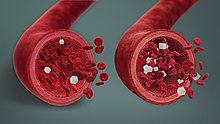
Back نقص سكر الدم Arabic Hipoqlikemiya Azerbaijani هیپوگلیسئمیا AZB Гіпаглікемія Byelorussian Хипогликемия Bulgarian হাইপোগ্লাইসিমিয়া Bengali/Bangla Hipoglucèmia Catalan Hypoglykemie Czech Hypoglykämie German Υπογλυκαιμία Greek
| Hypoglycemia | |
|---|---|
| Other names | Hypoglycaemia, hypoglycæmia, low blood glucose, low blood sugar |
 | |
| Hypoglycemia (left) and normal blood sugar concentration (right) | |
| Specialty | Endocrinology |
| Symptoms | Headache, blurred vision, shakiness, dizziness, weakness, tiredness, sweating, clamminess, fast heart rate, pounding heartbeat, nervousness or anxiety, hunger, nausea, pins and needles sensation, difficulty talking, confusion, unusual behavior, lightheadedness, pale skin color, seizures[1][2][3][4][5] |
| Complications | Loss of consciousness, death |
| Usual onset | Rapid[1] |
| Causes | Medications (insulin, glinides and sulfonylureas), sepsis, kidney failure, certain tumors, liver disease[1][6] |
| Diagnostic method | Whipple's triad: Symptoms of hypoglycemia, serum blood glucose level <70 mg/dL (3.9 mmol/L), and resolution of symptoms when blood glucose returns to normal[2] |
| Treatment | Eating foods high in simple sugars |
| Medication | Glucose, glucagon[1] |
| Frequency | In type 1 diabetics, mild hypoglycemia occurs twice per week on average, and severe hypoglycemia occurs once per year.[3] |
| Deaths | In type 1 diabetics, 6–10% will die of hypoglycemia.[3] |
Hypoglycemia, also called low blood sugar, is a fall in blood sugar to levels below normal, typically below 70 mg/dL (3.9 mmol/L).[1][3] Whipple's triad is used to properly identify hypoglycemic episodes.[2] It is defined as blood glucose below 70 mg/dL (3.9 mmol/L), symptoms associated with hypoglycemia, and resolution of symptoms when blood sugar returns to normal.[2] Hypoglycemia may result in headache, tiredness, clumsiness, trouble talking, confusion, fast heart rate, sweating, shakiness, nervousness, hunger, loss of consciousness, seizures, or death.[1][3][2] Symptoms typically come on quickly.[1]
The most common cause of hypoglycemia is medications used to treat diabetes such as insulin, sulfonylureas, and biguanides.[3][2][6] Risk is greater in diabetics who have eaten less than usual, recently exercised, or consumed alcohol.[1][3][2] Other causes of hypoglycemia include severe illness, sepsis, kidney failure, liver disease, hormone deficiency, tumors such as insulinomas or non-B cell tumors, inborn errors of metabolism, and several medications.[1][3][2] Low blood sugar may occur in otherwise healthy newborns who have not eaten for a few hours.[7]
Hypoglycemia is treated by eating a sugary food or drink, for example glucose tablets or gel, apple juice, soft drink, or lollies.[1][3][2] The person must be conscious and able to swallow.[1][3] The goal is to consume 10–20 grams of a carbohydrate to raise blood glucose levels to a minimum of 70 mg/dL (3.9 mmol/L).[3][2] If a person is not able to take food by mouth, glucagon by injection or insufflation may help.[1][3][8] The treatment of hypoglycemia unrelated to diabetes includes treating the underlying problem.[3][2]
Among people with diabetes, prevention starts with learning the signs and symptoms of hypoglycemia.[3][2] Diabetes medications, like insulin, sulfonylureas, and biguanides can also be adjusted or stopped to prevent hypoglycemia.[3][2] Frequent and routine blood glucose testing is recommended.[1][3] Some may find continuous glucose monitors with insulin pumps to be helpful in the management of diabetes and prevention of hypoglycemia.[3]
- ^ a b c d e f g h i j k l m National Institute of Diabetes and Digestive and Kidney Diseases (NIDDK). "Low Blood Glucose (Hypoglycemia)". NIDDK.nih.gov. Archived from the original on 28 July 2017. Retrieved 12 January 2022.
- ^ a b c d e f g h i j k l m Cryer PE, Axelrod L, Grossman AB, Heller SR, Montori VM, Seaquist ER, Service FJ (March 2009). "Evaluation and management of adult hypoglycemic disorders: an Endocrine Society Clinical Practice Guideline". The Journal of Clinical Endocrinology and Metabolism. 94 (3): 709–728. doi:10.1210/jc.2008-1410. PMID 19088155.
- ^ a b c d e f g h i j k l m n o p q Jameson JL, Kasper DL, Longo DL, Fauci AS, Hauser SL, Loscalzo J (2018). Harrison's principles of internal medicine (20th ed.). New York. ISBN 978-1-259-64403-0. OCLC 1029074059. Archived from the original on 29 August 2021. Retrieved 12 January 2022.
{{cite book}}: CS1 maint: location missing publisher (link) - ^ Cite error: The named reference
Young_2016was invoked but never defined (see the help page). - ^ American Diabetes Association (ADA). "Hypoglycemia (Low Blood Glucose)". www.diabetes.org. Archived from the original on 13 January 2022. Retrieved 12 January 2022.
- ^ a b Yanai H, Adachi H, Katsuyama H, Moriyama S, Hamasaki H, Sako A (February 2015). "Causative anti-diabetic drugs and the underlying clinical factors for hypoglycemia in patients with diabetes". World Journal of Diabetes. 6 (1): 30–36. doi:10.4239/wjd.v6.i1.30. PMC 4317315. PMID 25685276.
- ^ Cite error: The named reference
:7was invoked but never defined (see the help page). - ^ "FDA approves first treatment for severe hypoglycemia that can be administered without an injection". FDA. 11 September 2019. Archived from the original on 17 May 2020. Retrieved 11 November 2019.
© MMXXIII Rich X Search. We shall prevail. All rights reserved. Rich X Search